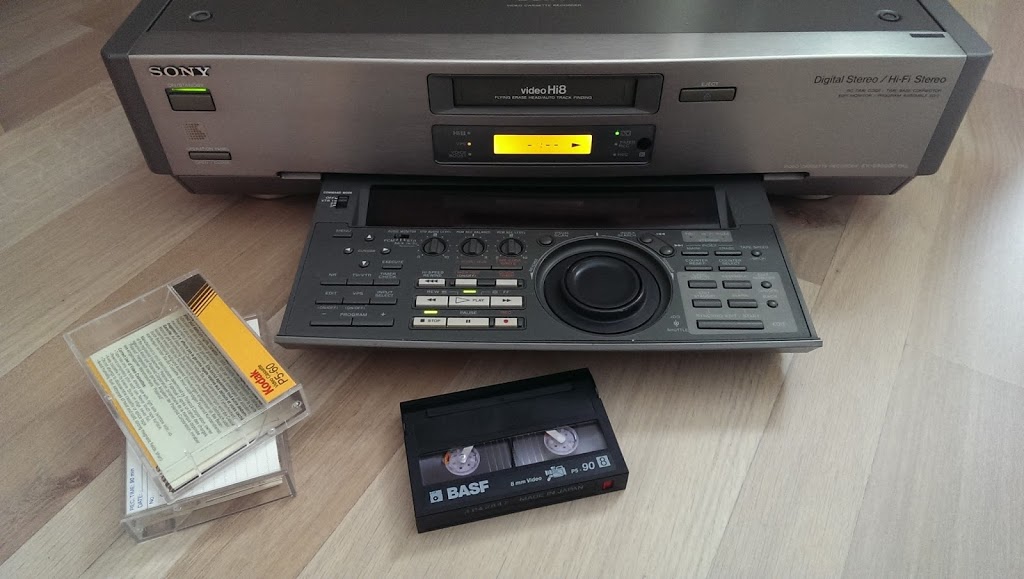![]()
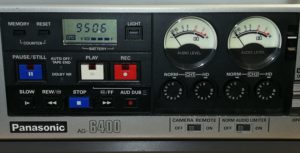
A new member of the collection of old multimedia devices is the Panasonic AG-6400. The AG-6400 is a (semi) professional video recorder from the 80s. The device records on VHS magnetic tapes and also reproduces this standard. It is portable and was the recorder for the video cameras of that time. It draws its energy from 12V NP1 batteries and can provide approx. 27W for the camera connected to it. That was about the power requirement of a 3-tube camera.
This device, too, had gotten some traces of time that largely restricted its function. Simply said – it was broken. This defect manifested itself in a stuck capstan shaft . At first I thought the shaft was ‘seized’ due to corrosion, but the reason was completely different. Interestingly, a ball bearing had been pressed out of its press fit, so that the flywheel attached to the shaft touched the bobbin of the capstan motor. The magnets in the flywheel held it in place. This error could be easily and quickly remedied by pushing back the ball bearing and then fixing it.

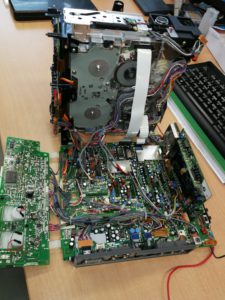
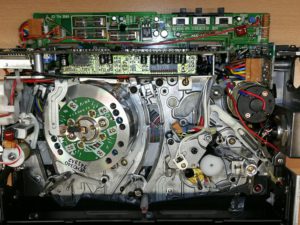
After the mechanical fault was repaired and a first function test, a fault in the 5V power supply was still to be found on the power board. This was expressed by a failure to start all drives. Here, an IC fuse was defective in the switching converter. This was triggered by a defective Schottky diode in the buck converter circuit. This bug was also quickly solved. And after checking and adjusting the operating voltages according to the setpoints in the service manual, the drive did its job again. I was even amazed at the excellent image quality that the device could reproduce. Due to its compact dimensions, I can even use the AG6400 to digitize old VHS tapes in the future.
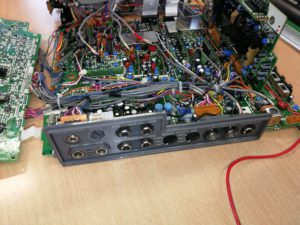

In the data sheets and advertising for the AG-6400, the manufacturer has advertised some features and functions as follows:
High quality image reproduction
The tape speed corresponds to the VHS standard with a video track width of 49µm. Several technologies for clear and detailed image reproduction are combined in the device.
HI-FI Sound
A four-channel system consisting of two ‘normal’ audio channels with Dolby noise reduction and two ‘HD-Sound’ channels allow you to enjoy high quality recordings. A 3.5mm headphone jack and two 6.3mm microphone jacks for separate feeding of both channels, including separate control with VU meters, complete the range of audio options.
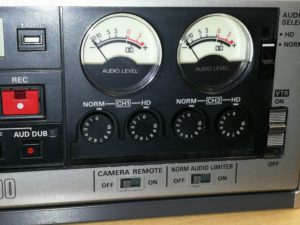
Time Code record and playback
For control in linear editing systems, the recorder enables the recording of external EBU timecode signals on channel 2 of the longitudinal track.
External camersocket
A connection for an external camera with a maximum power consumption of up to 27W is also available. Cameras with 3-tube Vidicon system can be connected here.
A diagram with the connection options is shown in the following picture:

Technische Daten:
| Manufacturer | National/Panasonic Central Osaka Japan |
| Year | ca. 1988 |
| System | VHS Portable Videorecorder |
| Powersupply | DC 10.5 to 16V |
| Powerconsumtion | 14Watt, (with camera ca. 41W) |
| Videosystem | Fourhead rotationsystem (helical scanning) |
| Luminanz | FM azimuth recording |
| Farbsignal | subcarrier phaseshift Recording |
| Video SNR | 43dB |
| Audiosystem | Normal und HD-Audio |
| Normalaudio | 1 fixed audiohead |
| HD-Audio | 2 rotating heads , 1 earasehead |
| Stereoton | Normalstereo (2Kanäle über Längsspur ) |
| HD-Stereo (2Kanäle über Schrägspur) | |
| TV-System | CCIR (625 Zeilen, 50Halbbilder) PAL Colour |
| tape speed | 23.39mm/s |
| rewind time(180min tape) | 4.5min |
| size | 222x90x270mm |
| weight | 3.0kg (without battery) |

